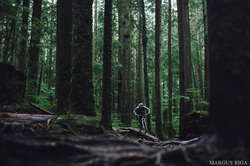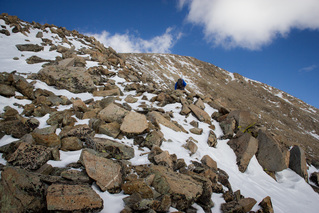 I recently read about the National Park Service's consideration of allowing mountain biking in Rocky Mountain National Park. They have set up a test-run on a short stretch of trail inside the park and will be preparing an environmental impact assessment to go along with it. There has always been resistance against making trails open to cyclists but it is usually on grounds of social interactions between hikers, horseback riders, and bicyclists. I will be the first to admit that there are inconsiderate riders out there that are bound to frustrate other trail users by blazing down the mountain without yield. However I think some clever steps taken by planners can help users avoid such interactions. The trails around the front range of colorado have very clear signage indicating who should yield to who, and some of the parks even have certain days of the week when cyclists are not allowed. The real question the NPS is addressing is this: is mountain biking measurably worse for the environment than other forms of trail use? I was curious what research has already been done on the subject and came across this comprehensive review done by the International Mountain Bicycling Association. Their key conclusion on the matter is quoted below: The environmental degradation caused by mountain biking is generally equivalent or less than that caused by hiking, and both are substantially less impacting than horse or motorized activities. In the small number of studies that included direct comparisons of the environmental effects of different recreational activities, mountain biking was found to have an impact that is less than or comparable to hiking. For example, Marion and Olive (2006) reported less soil loss on mountain bike trails than on hiking trails, which in turn exhibited substantially less soil loss than did horse and ATV trails. Similarly, two wildlife studies reported no difference in wildlife disturbance between hikers and mountain bikers (Taylor & Knight 2003, Gander & Ingold 1997), while two other studies found that mountain bikers caused less disturbance (Papouchis and others. 2001, Spahr 1990). As a mountain biker I hope that these facts are soon recognized by land managers so that the sport can keep progressing and exciting new terrain can be open for travel by bike.
0 Comments
 I recently listened to a Freakonomics podcast that draws attention to the relatively new issue of "bad environmentalism." They refer to the practice of companies and individuals that frequently use phrases like "eco-friendly" and "green" as a means to sell a product. The big example used in the piece is that of bamboo flooring, which has recently received the approval of the LEED building program as a green material. The fact of the matter is that the only thing green about bamboo is that it has a rapid renewal time. Many of the same issues with traditional timber still apply to it, such as land clearing, pesticide use, and impacts from shipping the material. There are plenty of sustainably produced timber products that have less of an impact on our environment than the bamboo operations. As a consumer it is very difficult to be fully informed on the life-cycle footprint of a product so we should all be wary when we hear a sales pitch from someone that has an obvious personal interest in the matter. In defense of the people selling "green" products, they themselves are probably not informed on the entire life-cycle analysis of their product either. On a positive note, it's great that a product's environmental rating has become a selling point for consumers in our country. I don't think that would have been the case a few decades ago.  In my previous post I discussed the benefits and drawbacks of crowdsourced scientific data collection, but I focused on very basic "see and report" methods. With sophisticated hardware technology getting cheaper every year it is now becoming more common for the general public to be involved in more high-tech scientific monitoring. The image above shows the most recent iteration of the Sensordrone, which was launched from a kickstarter campaign. This device makes use of the immense processing power of mobile devices to make sense of data. While most of the features of the Sensordrone are somewhat frivolous, it does have some potential uses for scientific endeavors e.g. precision gas, temperature, and pressure sensors. The device also has an expansion connector that would allow other sensors to take advantage of its bluetooth interface. I think consumer-level technology like this has tremendous potential for widespread environmental monitoring in the future. Another great example of the power of citizen monitoring is the Air Quality Egg. This application is much more focused on environmental concerns than the Sensordrone and could be very useful in urban areas. "The Air Quality Egg is a sensor system designed to allow anyone to collect very high resolution readings of NO2 and CO concentrations outside of their home. These two gases are the most indicative elements related to urban air pollution that are sense-able by inexpensive, DIY sensors."  One of the most amazing aspects of the modern smartphone age is the fact that everyone now has an extremely accurate GIS device right in their pocket at all times. There are many institutions that are taking advantage of this in terms of "big data" but what is intriguing to me is the potential to crowdsource scientific data. One organization, Adventurers and Scientists for Conservation, is taking full advantage of the concept. As a self-diagnosed adventurer I think it is especially cool to have the opportunity to contribute to research while exploring remote and extreme locations. I got a chance to report sightings of American Pika while climbing Mt. Democrat last November. In the picture above you can see where the Pikas were living, popping in and out of the talus and boulders on the mountain side. Pika are considered bio-indicators for climate change because they cannot survive in ambient temperatures above 78 degrees fahrenheit. Recording latitude, longitude, elevation, and time of day of Pika sightings will provide valuable information for ongoing climate studies that include remote locations that do not benefit from permanent weather stations. Crowdsourcing data collection has many benefits but I think there is one glaring weakness. The fact that most of the participants in projects like these are not scientists and will not be as thorough in their investigation. I do believe this weakness can be circumvented by researchers by asking the right questions and providing extremely clear and succinct instructions for participants, designed to be carried out by "citizens." This is an exciting time and I can't wait to see what comes out of the projects sponsored by ASC. I encourage anyone reading this to participate if they get the chance. |
Alex KeyScientist, photographer, and outdoor athlete based in Denver, Colorado. This blog is a place to share science-related news and ideas that I find interesting. Archives
June 2014
Categories
All
|

 RSS Feed
RSS Feed